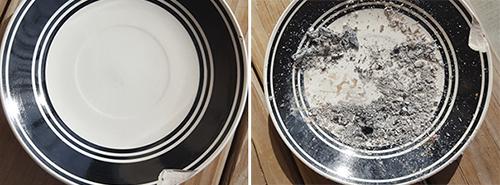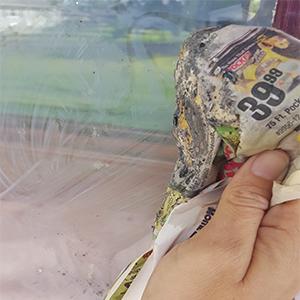Maybe you’ve heard about old timey uses for wood ash. It’s a remarkably useful substance even today, though. There are several uses for wood ash that may not only be applicable in your everyday life, but that could help you and your loved ones survive in a SHTF situation.
What Is Wood Ash?
Wood ash is exactly what it sounds like: that ashes that are the end product when wood is burned. You’ve probably considered them to be something to dispose of in the past, but this list of wood ash uses may change your mind and have you saving wood ash up for a rainy day!
Related: How to Make Firebricks (fire logs) and Wood Stove Logs for Free!
30 Survival Uses for Wood Ash
- Cleaning metal – Think of it a little like a natural version of scouring powder. You can use wood ash combined with a little water to form a thick paste to scrub metal items.
- Cleaning dirty dishes – Dishes need to be cleaned, even in a survival situation (maybe especially in a survival situation). Sprinkle a little wood ash on plates or in a skillet and give it a scrub to remove stuck on foods.

- Cleaning people – You may have heard of using sand to clean up, and ash can do the same thing. Simply scoop up a handful of (cool) ashes and start scrubbing. Then, rinse off with water.
 Clean glass doors on wood stoves – Oddly enough, ash does a great job breaking down soot. Use wood ash to clean the black grime off your wood stove door.
Clean glass doors on wood stoves – Oddly enough, ash does a great job breaking down soot. Use wood ash to clean the black grime off your wood stove door.- Soil amendment to replace lime – You can use wood ash to change the pH of soil, just like you would use lime. This works great for lawns, hay fields, and in gardens.
- Soil amendment to boost calcium – Eggshells are a great way to boost the calcium in your soil, but if you don’t have access to eggshells, wood ash will do the trick.
- Keep snails out of the garden – Snails and slugs can do significant damage Sprinkle wood ash around your garden to keep these slimy creatures out and your crops safe.
- Tomato growing – Wood ash is great for growing tomatoes! Just sprinkle a half cup in each hole before you plant.
- Soap making – When you mix wood ash with water, you get lye. When you mix lye with fat, you get soap!
- Chicken dust bath – Chickens love to roll around in the dust. When that dust contains at least some wood ash, it can help keep your poultry free from mites and other pests.
- Food supplement for chickens – People sometimes add eggshells or oyster shell to supplement their chickens with calcium, but if you can’t get your hands on those, wood ash will do in a pinch. Just be sure you empty food dishes so that water doesn’t sit in the ash, potentially creating lye.
- Compost booster – You can add wood ash to boost nutrients directly to compost, which helps create better compost in the long run.
- Camouflage – Being invisible to other people and animals might become a life or death situation at some point. Wood ash can be smeared on the skin in varying thicknesses to create a camouflage look. It may even help to disguise your human scent.
- Eliminate skunk smell – Make a paste of wood ash and vinegar, then smear it in to the sprayed pet’s fur to cut through the skunk smell.
- Create a glaze for clay or ceramic items – Follow these directions to create a basic glaze for ceramics from clay and wood ash. This sort of glaze is visually interesting because the various minerals in both the clay and the ash combine to create unique colors.
- Reduce friction between moving parts in simple machines – Ash is very fine and can help reduce friction between moving parts, like pulleys.
- Make glue – Mix wood ash and pine sap to create a passable glue.
- Waterproof wood – Mix wood ash and linseed oil to create a waterproofing agent for wood.
- Seed preservation – Simply sprinkle seeds with ash to prevent pest damage.
- Nixtamalization of corn for grinding – Use lye from wood ash to make corn easier to grind. This is also helps increase the nutritional value of the corn.
- Take the hair off hides – Make dehairing hides easier by mixing hot water with wood ash and soaking fresh hides in the mixture.
- Ice melt – Use it as a replacement for rock salt to melt ice.
- Fire retardant – Throw wood ash over a fire to smother it.
- Traction for tires on ice or mud – It’s grippy stuff when it gets damp! Just sprinkle it liberally around the tires to help gain some traction.
- Pest control in the home – Place some wood ash on basement or cellar floors to keep mice and other pests out. They hate the stuff!
- Flea, lice, and tick repellent – Sprinkle over pets or livestock to help repel biting pests.
- Soak up stains – Sprinkle wood ash over grease or oil spots on concrete to soak it up and get garage or basement floors sparkly clean.
- Wound cleansing – Some cultures have used wood ash to prevent bacteria in wounds.
- Other healing – Various types of wood ash have been used for complex healing over the centuries. It is even used in some modern pharmaceuticals.
- Sun protection – Just because the sunscreen runs out doesn’t mean or risk for sun burn will be eliminated. Particularly in a SHTF situation where you’re likely to be outdoors frequently, use wood ash dusted over the skin to protect you from the sun.
Related: 15 Survival Uses for Bentonite Clay
Wood Ash Safety
It’s important that you are careful not to inhale wood ash. Taking caution with wood ash and other chemical agents that we’ve learned can be made from wood ash is also very important. When used wisely, wood ash can help assure your survival. If it’s used improperly, it can have the opposite effect.
Practice some of these techniques now so that you are better prepared in the event that wood ash is the only option to solve applicable problems.
You may also like:
 50 Prepper Items To Shop For At The Thrift Store or Yard Sale
50 Prepper Items To Shop For At The Thrift Store or Yard Sale
How To Build An Underground Root Cellar And Bunker For Just 400 (Video)
The First Counties To Be Relieved By The Government After SHTF
How to Keep Grains Edible and Fresh for Over 40 Years With Nitrogen















Wood ash in your pit toilet will act like lime and reduce odors. It will also help break down the solids.
When I was young all the municipalities burned coal in the public buildings for hot water and to heat the building. They stored the ashes all year long and when there was a winter storm they spread the ashes on the streets and sidewalks. No one used salt that I ever heard. It was a win-win situation. It dispersed the ash and the public entity didn’t have to spend extra money on salt. We used the ashes during the summer from the hot water stove to spread on the ground to correct ph as you indicated above.
The problem with using wood ash to make lye is that your soap can be very caustic. If you have no other access to lye, then this will do but you need to be very careful with your soap and let it cure for at least 6 weeks, the longer, the better. Soap made with commercially-made lye will cure in 4 weeks or less.
I thought that and wondered about the advice to smear wood ash on your skin as camouflage. I think I will stick with mud. I can see where the caustic nature of ash would make a good antiseptic, much like burning a cut with a hot iron to close the wound. Some of the old time remedies were pretty brutal. Bleeding for example. There is a small window for certain types of physical problems where a small amount of bleeding would be therapeutic but it is my understanding that it is a very narrow, limited application. Not to be indulged in with the abandon that was formerly the practice of medicine men in the past. Oil is good for moving machinery. That does not mean that oil should be dripping from every surface of the machine.
Comparing — use wood ash and hot water to take hair off of hides. Use wood ash to protect your skin from the hot rays of the sun. If the rays of the sun are hot enough to burn your skin, your sweat is going to make the same mixture as the hide preparation potion. Has anyone on this list ever used wood ash in place of Coppertone or zinc oxide?
Would like to order the lost ways 2 but I’m in Alberta Canada is there a way to order ?
Hi, I live in Australia and had the same problem
I Used a Shipping Company in the USA called MYUS. Have been using them for other things I can’t get sent here too. Costs me $7 American a month. I think the 1st month was Free & you can Cancel at any time. Been Very helpful for me.
Sorry forgot to say that it’s in Florida
Good Luck
As commented to Kelly, down load it from the site. It will be in PDF format. From there, print it out, or just leave it as a digital file. Having a made up book is nice, but the down load is faster. You pay for it on line, such as through PayPal, if you have that option, then down load the file.
Down load it from the site.
Where are the directions ?
“…..Follow these directions to create a basic glaze for ceramics from clay and wood ash…..”
Please follow this link: https://ceramics.wonderhowto.com/how-to/make-simple-clay-and-ash-glaze-233849/
Wood ash mixed with a small amount of water to make a thick paste was used to make “chink”. Chink was the mud or material they used to seal the cracks or spaces between the logs of their log homes. This kept out the cold air during the winter.
What about ash from pellet stoves?
First, find out how the pellets are made. I am pretty sure that if chemicals are used in holding the wood particles together your not going to want to use the ash from them.
I lived near Hulett, WY, and there was a plant there that made pellets for wood stoves I believe. Sawdust was taken and rammed into small tubes and compressed tightly enough to keep it’s shape and then cut off to length and bagged. Hulett had a couple of sawmills there, and I believe it was Devil’s Tower Wood Products that made it. Glue was never used as I understood it. Glue would have gummed up the machine.
I found their website, but can’t paste the link here. Google Devil’s Tower Wood Products, and then scroll down to their products link, it’s 100% wood it says.
Thank you Doc, I will look it up, but a long ways to get pellets, they make some in Arkansas not to far from our home. I know at one time I called the manf of the pellets we used and he said it would be okay to use the ash and some pellets that got wet in the garden, for some reason they affected my tomatoes and have had nothing but bad luck since, so this year I have been removing all the soil in my raised bed before rebuilding them and making a new batch of soil using chicken litter and compost and sawdust and compost hoping my soil will be more productive.
EVERY label on store-bought ‘fire logs’ I’ve ever read indicates that PARAFFIN was used as a ‘binder.’
I didn’t expect the wood ash on dampened paper towels to clean the glass windows on my woodstove so effectively! I am amazed!
For several years I had been cleaning the char off the glass with a little white vinegar on a paper towel. It worked better than anything else I had tried, but the glass seemed old and tired, and I figured that was as good as it would get.
With the wood ash and damp paper towel, the glass is as clear and sparkling as new! Thanks!
Cool Thanks heaps for posting that !
Will try it soon 🙂
Mix some with powdered glass and salt, put it in a pneumatic cannon (potato gun concept) and you have a blinding, non lethal alternative. Close range, obviously.
I just use plain water or some glass cleaner to clean the glass on my pellet stove. Have to wipe it down 2 times to insure that the glass is clean.
so great to find informed reading on this almost obscure common knowledge of simple effective resources like wood ash! so glad I asked a little but was answered alot
DO NOT REPEAT DO NOT use treated lumber or boards Creosote poles in the burn pile to make would ash.
They all have some nasty stuff in them. Just use limbs or tree logs that you have cur down or whatever.
I am not sure about burning Pine or Evergreen trees in the pile you are making/using for/to make Wood Ash.
It is dangerous to burn pine logs in your fireplace as it will cause serious build up in the chimney and cause a fire you do not want to happen.
Using Fat lighter or trading wood (comes pine stumps or knots, etc,that are hard and full of the pine sap) to start fires is ok….. Usually they are split into small pieces and sold in bundles..OR you can find them for yourself in a lot of areas
I have also heard burning Cedar (Christmas Tree an Evergreen) is TOXIC to cook over or roast wienies and Marsh mellows or other food.
BEFORE using the ash I would make sure it was only natural wood. Perhaps using a sheet of newspaper and a little cooking to make a wick and start the fire would be okay……I have no answer if that would be safe or make any difference in using the Wood Ash….. But doubt such a small amount would make any difference…. beside we cook with it……
Paper is made from wood pulp, so the ash that would be residual from burning paper would be similar to wood ash.
Please not that I am not a chemist and did not do well in my inorganic chemistry class.
People fret about the ink on the paper. Food has traditionally be wrapped in newsprint and we seemed to have had no ill effect from it, even when black ink was made from lampblack and linseed oil. Currently a lot of inks are soy oil based although not all of them.
If you bank your fire at night, you should have coals in the morning to restart your fire. It shouldn’t be necessary to restart your fire with newsprint every morning. Slick paper is generally clay coated and should be non-toxic.
Ash is chock-full of nutrients for plants. However, putting fresh ash into the holes into which you plant anything, not just tomatoes, will burn them. Either keep the ash in a a leay barrel, over winter, so that continuous water flow washes away most of the lye, or mix it with sawdust and keep it a few days wet in a bucket, so the lye can be neutralized at least partially by the tannin from the wood.